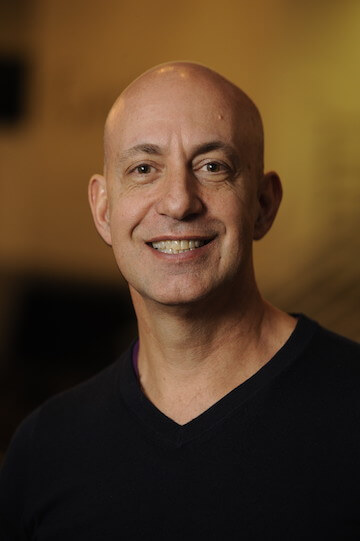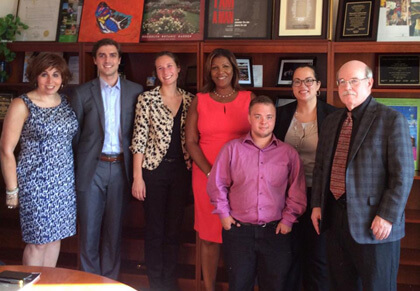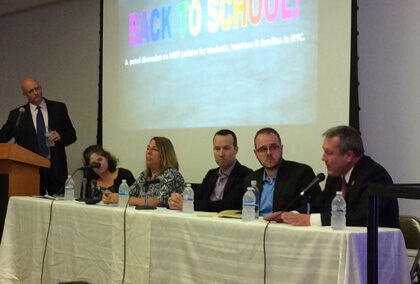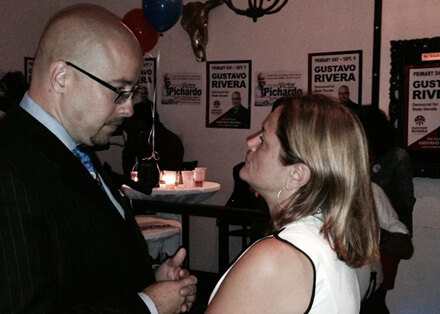A rendering of Anthony Goicolea’s design for the LGBT Memorial planned for Hudson River Park, showing the glass prisms in the rock design as well as the rainbows they cast on the surrounding grass. | OFFICE OF THE GOVERNOR
In a process that one commissioner described as “efficient,” the consultants and 10 commissioners who were charged with presenting Governor Andrew Cuomo with a panel of choices for the LGBT Memorial to be erected in Hudson River Park in the West Village took less three months to choose three proposals out of the 40 submitted.
“I think we selected three finalists,” said Scott Campbell, the executive director of the Elton John AIDS Foundation and one of the 10 commissioners. “We winnowed it down to the ones that met all the criteria and we thought were the most compelling.”
Cuomo announced the memorial on June 26, 2016, just 14 days after a gunman killed 49 people in an LGBTQ nightclub in Orlando, Florida. The memorial is intended to honor those 49 people and to “stand as an international symbol against ignorance, hate, bigotry, and gun violence,” read the executive order that created the commission.
Cuomo’s “efficient” way of settling on an LGBT Memorial design
The LGBT Memorial Commission, which included Christine Quinn, an out lesbian and former speaker of the City Council, and Eunic Ortiz, then the president of the Stonewall Democratic Club of New York City, an LGBTQ political club, had to include “individuals with a range of perspectives, interests, and specific knowledge concerning the LGBT community.”
Cuomo required that the commission complete its work by December 31, 2016.
The work began when HRPT hired historian and architect John Reddick as the project’s art consultant and Studio Hip Landscape Architecture, a three-person Manhattan firm, according to records obtained by Gay City News under the state Freedom of Information Law from the Cuomo administration, the state parks department, and the Hudson River Park Trust (HRPT), which operates the park that extends from West 59th Street to Battery Park. The contract for the art consultant team was worth $75,000, with Reddick apparently earning $48,000 and $14,000 going to the firm. Another $10,000 was paid to “staff” and $3,000 was paid out in “reimbursables.” Two other firms bid on that contract.
Reddick, who is openly gay and serves on the board of Harlem Pride, and Studio Hip began work in September and signed their contract with HRPT in early November. They were charged with soliciting proposals from artists and developing the process that the commissioners would use to make their selections.
The commission’s first meeting was on September 20, 2016, and requests for proposals to design and build the memorial were issued just eight days later. Artists who wanted to bid had until October 10 to ask questions and get answers from the art consultant team during what the documents called the “artists question period.” Final submissions were due by October 28, with artists limited to 10 pages in their response. The response had to include the artist’s qualifications, a statement of intent, renderings and elevations of the work, and a budget. The budget for the memorial is $800,000 and the artist’s fee could be no more than 20 percent, or $160,000, of that budget.
The art consultant team was supposed to develop a “short list” of 10 to 12 designs for the commissioners to consider by November 11. The commissioners would score the designs on the “short list” on nine criteria, such as “Interpretation/ Clarity of Theme,” “Creativity & Originality of Depicted Theme,” and “Site Compatibility,” on a scale of 1 to 5, with four of the nine referring explicitly to the LGBTQ community. The commissioners were expected to deliver five choices to Cuomo by November 18 who was to select the “Winner, Runner-Up, and Honorable Mention” by December 5. The public announcement was to come some time between December 5 and December 31.
“I thought it was extremely well done and efficient,” Campbell told Gay City News.
The other commissioners either declined comment or did not respond to requests for comment.
The commission received 40 designs. Of that number, only 25, by Gay City News’ count, complied with the submission instructions. It is unclear if the 15 that did not comply were disqualified. While the state parks department released the 40 submissions, the agency did not release any documents indicating how many of the submissions were scored.
Of the 25, the commissioners received “15 or so,” Campbell said. The commissioners were free to review all the submissions on a state parks department website. They presented Cuomo with three choices — a design by Jordan Eagles and Spilios Gianakopoulos, another by Moshe Yehosuoua, and what would be the winning design by Anthony Goicolea.
One of the fabricators of a component of Goicolea’s design said the memorial has a planned opening this spring.
In a written statement, the state parks department said the “three finalists spent six months, January 2017–June 2017 enhancing their designs for final presentation before members of the LGBT Memorial Commission and representatives to the Governor in mid-June 2017.”
Gay City News received the original and revised submissions only for Goicolea and Eagles and Gianakopoulos. In both, the page count increased from eight pages to 14. Yehosuoua’s revised submission was 10 pages long. The original submissions were limited to eight pages. The three finalists were informed of their status by Reddick in a May 8, 2017 letter. Other documents suggest that the commission met once or twice and had one conference call during the first six months of 2017.
Cuomo announced the winner on June 25, 2017, the day of New York City’s annual pride parade. Announcing on that day guaranteed Cuomo the maximum press coverage.
“Ultimately artist Anthony Goicolea’s design was recommended by the Commission and selected as a result of the circular layout and permanency of the bronze stones that expressed the uncompromised strength of LGBT community, marries well within the sites natural environment, invites sitting and contemplation and stands for equality, fairness, justice, and equal rights for lesbian, gay, bisexual and transgender citizens,” the state parks department said in its statement.



































